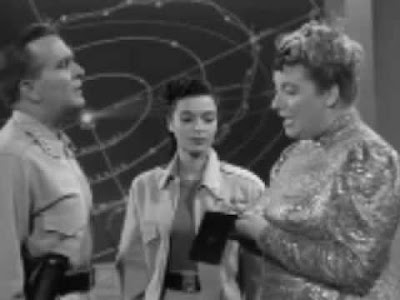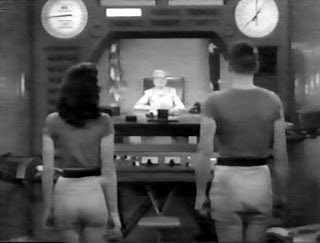
A
film with potentially good ideas but fails to take us forward into the future
Director: Richard Talmadge
Producer: Jack Seaman
Screenplay: Robert A. Heinlein; Jack
Seaman
Story: Robert A. Heinlein; Jack Seaman
Music: Herschel Burke Gilbert
Cinematography: William C. Thompson
Editing: Roland Gross
Studio: Galaxy Pictures Inc.
Distributor: Lippert Pictures
Running time: 63 minutes
Cast
Donna Martell: (Colonel Briteis)
Hayden Rorke: (Gen. 'Pappy' Greene)
Ross Ford: (Maj. Bill Moore)
Larry Johns: (Doctor Wernher)
Herb Jacobs: (Mr. Roundtree)
Barbara Morrison: (Polly Prattles)
Ernestine Barrier: (Madame President)
James Craven: (Commodore Carlson)
John Hedloe: (Adjutant)
Peter Adams: (Captain Carmody)
Trailer

“In 1948 the Secretary of Defence proposed that the
United States build a space station as a military guardian of the sky.
By 1954 atom bombs and intercontinental rockets made it a necessity.
In 1966 the first orbital flight was made by Colonel Briteis.
By 1970 the space station has been built and free
men were reaching for the moon to consolidate the safety of the Free World.
But while this was going on, the enemies of Freedom
were not idle—they were working to destroy the space station.”

Synopsis





The US authorities use this unexpected outcome to make the stranded spaceship the first component of a new moon base. In order to avoid the then morally unacceptable scenario of an unmarried male and female alone within the close confines of the space craft for an extended period of time, General Greene convinces Major Moore to propose to Colonel Briteis. As a newly promoted Brigadier General and ranking officer after their marriage, Moore will effectively be her boss.
Points Of interest


Fast forward now 60 years and we’re in Australia in the year 2013. We have just witnessed the ousting of this country’s first female Prime Minister by her own political party. In both the media and political spheres there was quite a nasty campaign launched against this female PM in large part on the basis of her gender. Such terms as “witch” were hurled against her and references were made concerning her marital status and lack of children. Such personal attacks and references would not be made if the PM had been a male. A few months later, the male opposition leader during the election campaign referred to one of his party’s young female candidates as having “sex appeal.” Journey around the world in 2013 and you’ll see many forms of gender inequality including such things as unequal rates of pay, misogynist attitudes, corporate glass ceilings, outmoded medieval religious attitudes and practices that subjugate and discriminate against women, and on it goes. In 60 years we may have come a long way in matters of gender, but how much further do we still need to go before we do not even have to think about it as needing to be an issue?

And so rewind to 1953 and we see in Project Moon Base a full colonel being demeaningly referred to by her general as “bright eyes,” and told that the only reason she flew the first orbital mission was because she weighed only ninety pounds and could fit into the spacecraft and is scolded as if she is a little girl with comments like, “Any more guff out of you and I’ll turn you over my knee and spank you.” Sixty years later and is it any wonder we have inquiries around the world into various countries’ armed forces and their sexist and abusive treatment of female recruits when attitudes like that are so ingrained in a culture?

Let’s still hold onto our gap of 60 years and consider society’s perception and treatment of overweight and obese people. These members of our society have lately become objects of entertainment and targets of actual and potential discrimination. How many of us from time to time have sat slack-jawed and gawped at obese people as they are being systematically ‘tortured’ by semi-fascist “trainers” in TV reality shows like “The Biggest (Whatever).” Suggestions have even been made to deprive obese people of certain fundamental services or at least charge them more for their use. Rewind to 1953 and what do we see in Project Moon Base? Polly Prattle, being rather of full figure and of course obsessed with her weight, is fascinated by the prospect of weightlessness. When she asks General Greene if she could travel to the space station he informs her that since it costs over $300 a pound to launch objects to the space station, all passengers would need to weigh less than 160 pounds. In other words, ‘lady you’re too fat to meet the weight limit.’ And so we chuckle and are suitably entertained. My, we’ve come a long way!

Not only in matters of gender is the film a product of its times, but it is also reflects the fears and concerns of the early Cold War era. Missile and nuclear development would usher in the era of the hydrogen bomb and the ICBM missile. In the film we are presented with a foreign spymaster (we all know from where without needing to be told!) who has recruited hundreds of people who physically resemble scientists who may be asked to travel to the American space station. This spy happens to have an agent who closely resembles Dr. Wernher and will take his place and be used to destroy the space station. Espionage, sabotage and subversion were themes the American public were encouraged to become familiar with.

It was an interesting idea to use basic split screen techniques to show people walking on different planes or appearing to be sitting on the floor while others are sitting on the wall. At least it graphically shows how relative or even non-existent such concepts as “up” & “down” can be in space. Living and working in space for extended periods do and will require major physical and mental readjustments for terrestrially evolved humans. A similar effect was achieved by using angled shots for the space station interior which makes the viewer feel that they’re in space aboard a space station. One day we may have to make concerted efforts to remember not to walk on the walls!


Project Moon Base originally started out as a pilot episode called Ring Around the Moon for a proposed television series called The World Beyond. Still, the film is very short, in fact too short. With this mind, it is a shame that so much time is filled with explanations of various kinds such as General Greene’s explanations to Ms Prattle and a presumably perceived technically illiterate audience concerning the effects of weightlessness, rendezvous procedures, and the Luna mission. It’s not just Ms Prattle doing the prattling!

In the film, Project Moon Base, it was explained that America had to reach the moon first, before any other power. A decade and more later throughout the 1960’s, it was this race to be the first that provided the main impetus and rationale for the effort to fulfil JFK’s undertaking for the US to be the first to put a man on the moon and return him safely to the earth. The science involved in such a mission would tend to take a back seat and would not provide a sufficient rationale for such a risky and expensive enterprise as landing on the Moon. Perhaps General Greene’s words come closest to what always motivates the US in all matters terrestrial and extra-terrestrial: “Ma’am, the most important thing in the world to me is the military security of the United States, and I’m not the least apologetic about my attitude.”

As Moore, Briteis, and Dr. Wernher are ferried to the space station I couldn’t help wondering what self-respecting astronaut would succumb to being forced to wear a tee-shirt, a felt skull cap, and a pair of short shorts. Yes, the tune “Who wears short shorts?” went through my head. Sure, the outfit highlighted Briteis, wonderful physical attributes which I suspect was one of the reasons for the use of such space-wear. Notice how Briteis is forced down onto her acceleration couch during the struggle between Moore and Wernher, while the camera serves up views of her tee-shirt hugged chest area valiantly resisting the G-forces of acceleration. As the space program has developed over the decades we have seen astronauts perform their duties aboard spacecraft while being attired in casual clothes, instead of being required to permanently don their spacesuits.

With “Public opinion being what it is,” no-one’s sensibilities are going to offended or any social mores transgressed with Major Moore and Colonel Briteis’ long-distance wedding ceremony, with Major Moore being promoted to Brigadier General and outranking his wife and with Moore and Briteis finally ending their constant bickering and finally kissing at the end of the movie. Project Moon Base: A journey into the future or a trip back to the future? A giant leap forward, or one step forward and two steps back? You decide……

©Chris Christopoulos 2013

And so rewind to 1953 and we see in Project Moon Base a full colonel being demeaningly referred to by her general as “bright eyes,” and told that the only reason she flew the first orbital mission was because she weighed only ninety pounds and could fit into the spacecraft and is scolded as if she is a little girl with comments like, “Any more guff out of you and I’ll turn you over my knee and spank you.” Sixty years later and is it any wonder we have inquiries around the world into various countries’ armed forces and their sexist and abusive treatment of female recruits when attitudes like that are so ingrained in a culture?

Let’s still hold onto our gap of 60 years and consider society’s perception and treatment of overweight and obese people. These members of our society have lately become objects of entertainment and targets of actual and potential discrimination. How many of us from time to time have sat slack-jawed and gawped at obese people as they are being systematically ‘tortured’ by semi-fascist “trainers” in TV reality shows like “The Biggest (Whatever).” Suggestions have even been made to deprive obese people of certain fundamental services or at least charge them more for their use. Rewind to 1953 and what do we see in Project Moon Base? Polly Prattle, being rather of full figure and of course obsessed with her weight, is fascinated by the prospect of weightlessness. When she asks General Greene if she could travel to the space station he informs her that since it costs over $300 a pound to launch objects to the space station, all passengers would need to weigh less than 160 pounds. In other words, ‘lady you’re too fat to meet the weight limit.’ And so we chuckle and are suitably entertained. My, we’ve come a long way!





“We
choose to go to the moon. We choose to go to the moon in this decade and do the
other things, not because they are easy, but because they are hard, because
that goal will serve to organize and measure the best of our energies and
skills, because that challenge is one that we are willing to accept, one we are
unwilling to postpone, and one which we intend to win, and the others, too…..
….To
be sure, we are behind, and will be behind for some time in manned flight. But
we do not intend to stay behind, and in this decade, we shall make up and move
ahead.”(Excerpt from JFK Moon Speech, September 12, 1962)




No comments:
Post a Comment